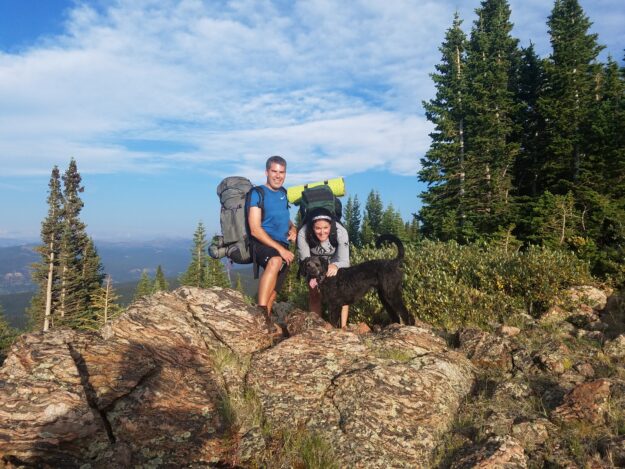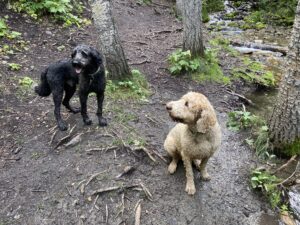Widgetized Section
Go to Admin » Appearance » Widgets » and move Gabfire Widget: Social into that MastheadOverlay zone
Some invaluable advice from Real Vail, Purina on climbing, hiking, traveling with dogs in Colorado

If your family is anything like mine – and I think we’re a fairly typical mountain-dwelling, dog-owning crew – you take your dogs just about everywhere with you in this great state.
Out to eat, to fancy hotels, beaches, paddleboarding (yes, we bought them their own PFD’s because they’re terrible swimmers), mountain climbing, skiing, you name it.
That presents some logistical challenges when you’re talking about two 70-plus-pound goldendoodles named Chuck and Monty.
So I decided to reach out to Purina, which I consider an iconic Colorado brand due to its prominence just north of downtown Denver and right along Interstate 70 (the same highway we live next to … just about 100 miles to the west in EagleVail).
I’ve even written about the Denver Purina plant, which most people used to know because of its unmistakable odor – something that has faded as an issue over the years.
Anyway, below you’ll find, I think, an invaluable Q&A with a Purina pet-care expert answering some of my, I think, perhaps obvious but still invaluable questions about traveling with your dogs and keeping them healthy, happy and safe.
First, however, a little background on just how tragically stupid I’ve been in the distant and not-so-distant past with my own dogs.
When I was 18 and a recent high-school graduate, I had a mutt named Morrison (I was a big fan of the band the Doors). My parents being boomer parents of the 80s loaned me a van and let my brother and a friend and I travel to California, where we went to Yosemite National Park.
I’ll never forget the park ranger telling us to keep our dog leashed. We did not. And he ran out across a barely visible waterfall and fell to his death.
It was a terrible tragedy, but one that was totally avoidable. Years later, I was telling someone the story and they said, “Never name your pet after a rockstar who died way too early.” He’d had a cat named Joplin who was run over by a car.
Fast forward to 2018, and we were climbing Mount of the Holy Cross, the only 14er in Eagle County, for my oldest son’s high school graduation. We summited with our dog Monty, but you cannot leash a dog on some parts of certain 14ers, where scree fields require bouldering and both hands.
Monty saw a pica and made a dash for a cornice of snow that perched above a thousand-foot drop-off. To this day, my three boys swear he almost went off. I swear it wasn’t that close, but lesson finally learned, I will never take my dogs on a 14er again.
Now my doodles love to do much lower-level hikes and come with us as we skin up and ski relatively benign slopes with low avalanche risk. But still, we were skiing last winter with Chuck’s brother, Loki, who lives in the city and isn’t used to skiing.

Loki crossed my skis and I wound up severing one of his tendons. He’s almost recovered, but again, lesson learned, and pet insurance proved critical for my in-laws who own Loki.
There is some debate on pet insurance these days, but I immediately reinstated insurance for both of my dogs (Embrace via my primary insurance company, USAA).
Those are some rather extreme examples of what can go wrong, but also vital cautionary tales if you’re considering traveling in the backcountry with your pooches. I’ve read so many stories about dogs lost in the wilderness or harrowing rescue missions off the high peaks.
Now here’s that Q&A with Purina expert Dr. RuthAnn Lobo. Lobos is a Senior Veterinarian at Nestlé Purina PetCare and a graduate of the Louisiana State University School of Veterinary Medicine. She is certified in canine rehabilitation and veterinary acupuncture through the Canine Rehabilitation Institute. She also is an active member of the American Veterinary Medical Association, American Academy of Veterinary Nutrition, American Association of Rehabilitation Veterinarians, and Colorado Veterinary Medical Association. Dr. Lobos resides in Boulder, Colorado, with her husband, son and three rescue pups – including a senior or geriatric Germain Shorthair Pointer, Stella, a stud athlete yellow Labrador Retriever, Finn, and a professional snuggler French Bulldog, Rigolets.
- How can I keep my dog safe from wild animals?
Before you go, doing some research on what animals you might come across can be helpful. Best practice is to keep them leashed when you’re hiking. Some facilities offer programs to train dogs how to react when they come across rattlesnakes and others have services to train them specifically for outdoor adventures with you. The more research you do ahead of time, the better prepared you’ll be.
- What can I do to protect my dog (or keep him calm) if he is on a leash but an unleashed dog comes toward us?
Leash training is imperative for any dog—both for their safety as well as their manners—and practicing interacting with off-leash dogs before you hit the trail will have you both prepared for that situation if it arises on a hike. Oftentimes, having training treats and reinforcing positive behavior will benefit two-fold: keeping your pup focused on you and building the mental association that “off-leash dog equals treat.” Keeping yourself calm will also help as dogs can read our body language and will often mirror our behavior. Using a calm voice, having your pup sit, and reassuring them can contribute to a positive experience for all. Lastly, stepping off the trail and away from the approaching dog can allow him to continue his way and give your dog the space he’d like.
- What breeds of dogs are most at risk for sunburns?
Many believe because dogs have fur, they are not susceptible to sunburn. Many types of dogs can burn, especially those with light or thin hair. Owners should also be aware of the area around the nose, which can very easily burn during extended time in the sun.
- When camping, what types of plants are most dangerous for dogs to eat?
In Colorado, common poisonous plants include the Death Camas, Western Water Hemlock, Larkspur, Locoweed and Lupine. Before you set off for adventure with your dog, brush up on your knowledge to avoid potentially serious issues if you pet encounters one of these plants. In general, these types of problem plants can be avoided by avoiding unkempt, weedy areas.
- Is it okay to keep my dog off the leash while camping if he is under voice command?
It’s easy to let your dog’s enthusiasm and sense of adventure get them into trouble. Keeping them on a leash will help keep them safe, and prevent them from interfering with wildlife, other dogs, or people.
- How can I prevent fleas and ticks?
There are multiple options available from your veterinarian—from topical to oral medications. Talking with them about which option is best for your specific dog is a great route to go. Lastly, doing a “once over” on your dog when you get back to the car or house is important to check for any ticks that may have hopped on and also for any little injuries that could have occurred while you were out on the adventure.
- How can I prevent my dog from getting carsick?
First and foremost, training your dog for car travel is crucial. A well-trained dog will cause fewer distractions in the car. Start with slow, gradual training to get the dog used to getting in and out of the car, the sounds of the doors, the engine and the horn. Positive reinforcement with treats or their favorite toy can help them associate car rides with a fun experience. Using a specific seatbelt/harness can also help keep them safe on the journey. You can also speak with your veterinarian about other medications or supplements that may help reduce the nausea.
- What water sources are OK for my dog to drink out of?
Ideally carrying fresh water for your dog (just like you do for yourself) is best. Steer clear of standing, stagnant water to help avoid parasites like giardia and other bacteria that can lead to gastrointestinal issues.
- Will my dog always know when he’s thirsty?
Dehydration in dogs can happen quickly, especially if they’re exerting a lot of energy in elevated temperatures. Plus, higher altitudes can increase your dog’s dehydration rate. Be sure to carry enough water for your dog as well as yourself, along with a bowl that allows your dog to get a good drink where they need it. A lightweight fabric bowl or a collapsible silicone bowl are easy to pack and use. There are also dog-specific water bottles that are easy to carry/clip on a backpack with a carabiner. A good rule of thumb is every time you stop for water or take a sip out of your hydration pack, stop and offer some to your dog.
- Is it wise to climb high peaks with my dog, like 14ers, or even 13ers and 12ers? What are the risks if I take him?
Dogs can get altitude sickness just like people can, but that doesn’t mean you have to leave them home when you venture out. Before you head out, a thorough physical examination by your veterinarian can help make sure your pup is healthy enough for the adventure. Dogs with heart and other medical conditions may not be the best companions for the summit, and your veterinarian can advise on your specific pet. Brachycephalic breeds like pugs, bulldogs, and Boston terriers may have a more difficult time breathing at higher altitudes. Also, dogs that are overweight can have an increased respiratory effort when they exercise, which could make them more susceptible to altitude sickness. Starting with shorter hikes at lower altitudes and gradually building both distance and elevation over time will help them adapt and be prepared for summitting with you. Always pack some food, treats and extra water for your four-legged companion to keep them fueled and hydrated along the way. Lastly, including a first aid kit in your backpack (or theirs) can be helpful if an emergency should arise.
**Another word of advice!
Have your dog’s microchip and ID tag information up to date and even consider something like an AirTag or GPS tracking collar on them should they get lost. There are a whole variety of brands who offer these—some that utilize cell signals and others that use satellite, depending on how far off the grid you’re going.



